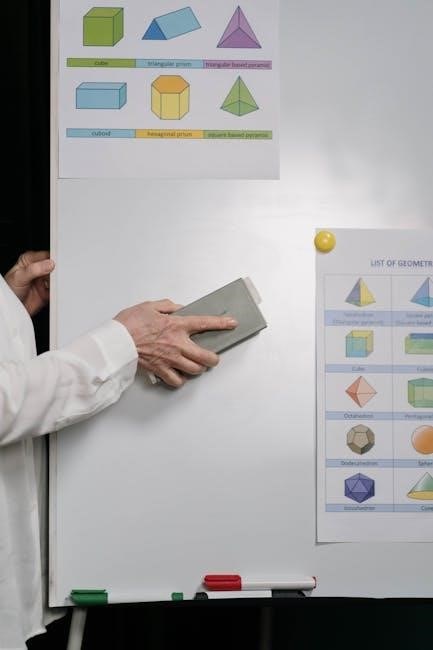Mathematical Methods in the Physical Sciences by Mary L․ Boas
Mary L․ Boas’s “Mathematical Methods in the Physical Sciences” is a widely used textbook․ It provides a comprehensive introduction to mathematical techniques․ These techniques are essential for students in physics, engineering, and related fields․ The book emphasizes problem-solving skills and includes various applications․
Overview of the Book
Mary L․ Boas’s “Mathematical Methods in the Physical Sciences” is a cornerstone textbook for students pursuing studies in physics, engineering, and chemistry․ The book presents a comprehensive survey of essential mathematical concepts․ It emphasizes developing problem-solving skills, which are crucial for advanced coursework․ Boas focuses on mathematical methods rather than deep dives into theoretical applications․ However, she includes numerous examples and simpler applications․
The book aims to equip students with a solid foundation in mathematical techniques․ It allows them to concentrate on physical applications in later courses․ The text covers a broad range of topics, including infinite series, complex numbers, linear algebra, partial differentiation, multiple integrals, and vector analysis․ It also explores Fourier series and their applications․ Boas’s clear and concise writing style makes complex topics accessible to undergraduate students․ The book remains a popular choice for instructors seeking to provide students with a robust mathematical toolkit․
Intended Audience and Prerequisites
“Mathematical Methods in the Physical Sciences” by Mary L․ Boas is primarily designed for undergraduate students․ These students typically are in their junior or senior year, pursuing degrees in physics, engineering, or chemistry․ The book assumes that students have a solid foundation in single-variable calculus․ A year or a year and a half of calculus is generally expected․ Familiarity with basic concepts like differentiation, integration, and limits is essential for grasping the material presented in the book․
While prior exposure to multivariable calculus or linear algebra can be beneficial, it is not strictly required․ Boas introduces these topics with sufficient detail․ This allows students without prior knowledge to follow along․ The book’s emphasis is on developing practical problem-solving skills․ It means students should be comfortable with algebraic manipulations and basic mathematical reasoning․ The text serves as a bridge between introductory calculus courses and more advanced topics in mathematical physics․ It is suitable for self-study or as a primary textbook in a mathematical methods course․
Key Topics Covered
Mary L․ Boas’s “Mathematical Methods in the Physical Sciences” covers a wide array of essential mathematical topics․ These topics are crucial for students pursuing studies in the physical sciences․ The book begins with a thorough treatment of infinite series and power series, laying the groundwork for understanding functions and their approximations․ Complex numbers are explored in detail․ This includes their algebraic properties, geometric representation, and applications in various physical contexts․ Linear algebra is another key component, covering vector spaces, matrices, eigenvalues, and eigenvectors, which are fundamental in quantum mechanics and other areas․
The text delves into partial differentiation, providing techniques for handling functions of multiple variables, essential for thermodynamics and fluid dynamics․ Multiple integrals, including double and triple integrals, are discussed, along with their applications in calculating volumes and other physical quantities․ Vector analysis is covered extensively, encompassing vector algebra, vector calculus, and important theorems like Green’s theorem and Stokes’ theorem․ The book also includes a comprehensive introduction to Fourier series․ It highlights their use in analyzing periodic phenomena and solving differential equations․ These topics collectively equip students with a robust toolkit for tackling mathematical problems in physics and related disciplines․
Infinite Series and Power Series
Infinite series and power series form a cornerstone of mathematical analysis․ They play a crucial role in approximating functions and solving various problems in physics and engineering․ Mary L․ Boas’s “Mathematical Methods in the Physical Sciences” provides a comprehensive treatment of these topics․ The book begins by introducing the fundamental concepts of convergence and divergence of infinite series, including tests like the ratio test, root test, and comparison test․ These tests allow students to determine whether a given series converges to a finite value or diverges to infinity․
Power series, which are infinite series involving powers of a variable, are then explored in detail․ The text covers the representation of functions as power series, such as Taylor series and Maclaurin series․ These representations are invaluable for approximating functions, especially when analytical solutions are difficult to obtain․ The book also discusses the properties of power series, including their radius of convergence and the operations of differentiation and integration․ These techniques are essential for solving differential equations and analyzing the behavior of physical systems․
Complex Numbers
Complex numbers, often denoted in the form a + bi, where ‘a’ and ‘b’ are real numbers and ‘i’ is the imaginary unit (√-1), are indispensable in various areas of physics and engineering․ Mary L․ Boas’s text meticulously introduces complex number theory, starting with basic arithmetic operations and progressing to more advanced topics․ The book elucidates the geometric interpretation of complex numbers, representing them as points in the complex plane or vectors․

The text then delves into complex functions, exploring their properties and behaviors․ Concepts such as analytic functions, Cauchy-Riemann equations, and contour integration are thoroughly discussed․ These concepts are vital for solving problems in electromagnetism, fluid dynamics, and quantum mechanics․ Furthermore, the book covers complex power series, including Taylor and Laurent series, which are powerful tools for analyzing complex functions․ These series allow for the representation of functions as infinite sums, facilitating approximations and problem-solving in complex domains․ The applications of complex numbers in physical sciences are highlighted, solidifying their importance in the field․

Linear Algebra
Linear algebra, a cornerstone of mathematical methods, provides the framework for solving systems of linear equations and analyzing vector spaces․ Mary L․ Boas’s “Mathematical Methods in the Physical Sciences” dedicates a significant portion to linear algebra․ The text begins with a comprehensive introduction to matrices and determinants, covering their properties and operations․ Matrix algebra, including addition, multiplication, and inversion, is thoroughly explained․ Determinants are explored in detail, with emphasis on their role in solving linear systems and determining matrix invertibility․
The book then delves into vector spaces, defining them abstractly and providing examples from various contexts․ Linear transformations between vector spaces are discussed, along with their matrix representations․ Eigenvalues and eigenvectors are introduced, highlighting their importance in solving differential equations and analyzing physical systems․ Diagonalization of matrices and its applications are also covered extensively․ The text concludes with a discussion of inner product spaces and orthogonal bases, which are essential tools in quantum mechanics and signal processing․ These concepts are presented with clarity, making them accessible to students with a basic calculus background, enhancing their understanding․
Partial Differentiation
Partial differentiation is a crucial tool in multivariable calculus, essential for analyzing functions that depend on multiple independent variables․ In “Mathematical Methods in the Physical Sciences,” Mary L․ Boas provides a thorough treatment of this topic․ The chapter begins by defining partial derivatives and exploring their geometric interpretation as slopes of tangent lines along specific directions․ Higher-order partial derivatives are introduced, along with the concept of mixed partials and conditions for their equality․
The text then delves into applications of partial differentiation, including finding critical points of multivariable functions and classifying them as maxima, minima, or saddle points․ The method of Lagrange multipliers is presented for constrained optimization problems․ The chain rule for partial derivatives is explained, enabling the differentiation of composite functions․ Taylor series expansions for multivariable functions are derived, providing approximations near a given point․ Vector calculus concepts, such as gradient, divergence, and curl, are introduced and related to partial derivatives․ These tools are illustrated with examples from physics and engineering, demonstrating their utility in solving real-world problems, making it easier for students․
Multiple Integrals
Multiple integrals form a cornerstone of calculus, extending the concept of integration to functions of several variables․ In “Mathematical Methods in the Physical Sciences,” Mary L․ Boas dedicates a chapter to providing a comprehensive understanding of this topic․ The chapter begins with a thorough introduction to double integrals, explaining how to evaluate them over rectangular and non-rectangular regions․ The concept of iterated integrals is introduced, illustrating how to reduce a double integral to a sequence of single integrals․ The change of variables is discussed, focusing on transformations to polar coordinates for simplifying integrals over circular regions․

The text then progresses to triple integrals, demonstrating their evaluation in Cartesian, cylindrical, and spherical coordinate systems․ Applications of multiple integrals are explored, including calculating areas, volumes, masses, and centers of mass of various objects․ The Jacobian determinant is introduced, providing a systematic approach to changing variables in multiple integrals․ The chapter concludes with examples of multiple integrals in physics, such as calculating moments of inertia and gravitational attraction․ The importance of understanding the geometry is stressed to ease the comprehension․
Vector Analysis
Vector analysis, a crucial component of mathematical methods for physical sciences, is thoroughly covered by Mary L․ Boas․ This section introduces vector algebra, including vector addition, subtraction, and scalar multiplication, laying the groundwork for more complex operations․ The dot product and cross product are defined, with explanations of their geometric interpretations and applications in calculating work and torque․ Vector calculus is then introduced, covering vector functions, their derivatives, and integrals․
Key concepts such as gradient, divergence, and curl are defined and their physical interpretations are explored․ The text provides numerous examples of how these operators are used to describe vector fields in physics, such as electric and magnetic fields․ Line integrals, surface integrals, and volume integrals are explained, along with the fundamental theorems of vector calculus: Green’s theorem, Stokes’ theorem, and the divergence theorem․ These theorems are shown to relate integrals over different dimensions, providing powerful tools for solving problems in electromagnetism, fluid dynamics, and other areas of physics․ The chapter emphasizes problem-solving․

Fourier Series
The section on Fourier series in “Mathematical Methods in the Physical Sciences” by Mary L․ Boas provides a detailed exploration of representing periodic functions as a sum of sines and cosines․ The chapter begins by introducing the basic concepts of periodic functions, orthogonality, and the determination of Fourier coefficients․ Various examples of periodic functions, such as square waves, sawtooth waves, and triangular waves, are analyzed to illustrate the computation of their Fourier series representations․
Convergence criteria for Fourier series are discussed, including the Dirichlet conditions, which ensure the pointwise convergence of the series․ The Gibbs phenomenon, an overshoot near discontinuities, is also explained․ Applications of Fourier series in solving differential equations are presented, demonstrating how to find particular solutions for equations with periodic forcing functions․ The use of Fourier series in signal processing is highlighted, showing how they can be used to analyze and synthesize signals․ The chapter includes numerous exercises to reinforce the concepts․ The complex form of the Fourier series is also covered, providing a more compact representation․
Applications in Physical Sciences
The “Mathematical Methods in the Physical Sciences” by Mary L․ Boas emphasizes the practical applications of mathematical techniques across various physics domains․ The book integrates applications into each chapter, demonstrating the relevance of mathematical methods․ These applications span areas like classical mechanics, electromagnetism, quantum mechanics, and thermodynamics․
In classical mechanics, mathematical methods are used to solve problems related to oscillations, waves, and central force motion․ Electromagnetism benefits from vector calculus, differential equations, and complex analysis․ Quantum mechanics relies on linear algebra, differential equations, and special functions for solving the Schrödinger equation․ Thermodynamics uses partial differential equations and integral transforms to analyze heat transfer and fluid dynamics․ The book also touches upon applications in optics, acoustics, and materials science․ Numerical methods are introduced for solving problems that lack analytical solutions․ Each application is presented with clear examples and exercises, connecting the theory to real-world problems․ The text prepares students to tackle advanced physics courses․
Availability and Editions
“Mathematical Methods in the Physical Sciences” by Mary L․ Boas has been available for several decades, witnessing multiple editions․ The book is widely accessible in libraries and bookstores, both physically and digitally․ The primary edition is the third, which includes updated content and expanded problem sets․
Earlier editions, while still valuable, may lack some of the more recent developments and applications․ The textbook is available in hardcover and softcover formats, catering to different preferences․ Digital versions, including PDFs and e-books, are readily found on various online platforms․ Some websites offer solutions manuals, aiding students in problem-solving․ Used copies are often available at reduced prices, making the book accessible to students with limited budgets․ International editions may also exist, tailored for specific regions․ It is crucial to ensure the edition being used aligns with the course requirements․ Access to online resources and supplementary materials might vary depending on the edition․
